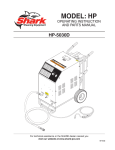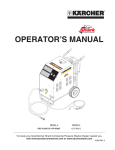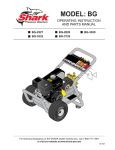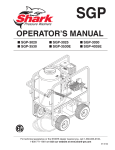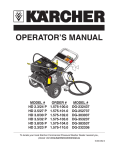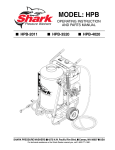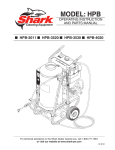Download Shark HP-5030D Operating instructions
Transcript
MODEL: HP OPERATING INSTRUCTION AND PARTS MANUAL ■ HP-5030D For technical assistance or the SHARK dealer nearest you, call 1-800-771-1881 or visit our website at www.shark-pw.com #97-6133 CONTENTS Introduction 4 Important Safety Information 4-5 Installation 5,7 Component Identification 6 Starting and Operating Instructions 7 Preventative Maintenance 7 Maintenance and Service 8-9 Field Service of Fuel Pump 9 Machine Assembly Exploded View 10 Machine Assembly Exploded View Parts List 11 Burner Assembly, Exploded View 12 Burner Assembly Exploded View Parts Lists 13 Troubleshooting 14-15 Preventative Maintenance 16 Warranty Model Number ______________________________ Serial Number ______________________________ Date of Purchase ___________________________ The model and serial numbers will be found on a decal attached to the pressure washer. You should record both serial number and date of purchase and keep in a safe place for future reference. 3 97-6149, 97-6162, 97-6133 • REV. 11/04 PRESSURE WASHER OPERATOR’S MANUAL INTRODUCTION & IMPORTANT SAFETY INFORMATION All information in this manual is based on the latest product information available at the time of printing. This machine is designed to heat water from a cold water pressure washer. Maximum water flow is 5 GPM and maximum pressure is 3000 PSI. Flow rate of 3 GPM will achieve an average temperature of about 180°F. Temperature is dependent on inlet water temperature and water flow rate. We reserve the right to make changes at any time without incurring any obligation. Owner/User Responsibility: The owner and/or user must have an understanding of the manufacturer’s operating instructions and warnings before using this hot water generator. Warning information should be emphasized and understood. If the operator is not fluent in English, the manufacturer’s instructions and warnings shall be read to and discussed with the operator in the operator’s native language by the purchaser/owner, making sure that the operator comprehends its contents. WARNING RISK OF FIRE. DO NOT USE WITH FLAMMABLE LIQUIDS. When ordering parts, please specify model and serial number. IMPORTANT SAFETY INFORMATION CAUTION CAUTION: To reduce the risk of injury, read operating instructions carefully before using. READ OPERATOR’S MANUAL THOROUGHLY PRIOR TO USE. 1. Read the owner's manual thoroughly. Failure to follow instructions could cause malfunction of the machine and result in death, serious bodily injury and/or property damage. 2. All installations must comply with local codes. Contact your electrician, plumber, utility company or the selling distributor for specific details. To comply with the National Electrical Code (NGPA 70) and provide additional protection from risk of electric shock, this hot water generator is equipped with a UL approved ground fault circuit interrupter (GFCI) power cord. WARNING: Do not use gasoline, crankcase drainings or oil containing gasoline, solvents or alcohol. Doing so will result in fire and/or explosion. WARNING: Do not spray flammable liquids. Operate only where an open torch is permitted. 3. This fuel burning machine shall be installed only in locations where combustible dusts and flammable gases or vapors are not present. 4. In these oil burning models, use only kerosene, No. 1 home heating fuel, or diesel fuel. WARNING Owner and/or user must study and maintain for future reference the manufacturers’ instructions. This manual should be considered a permanent part of the machine and should remain with it if machine is resold. WARNING: Flammable liquids can create fumes which can ignite causing property damage or severe injury. WARNING: Keep water spray, wand and high pressure hose away from electric wiring or fatal electric shock may result. Read warning tag on electrical cord. 5. To help protect the operator from electrical shock, the machine must be electrically grounded. It is the responsibility of the owner to connect this machine to a UL grounded receptacle of proper voltage and amperage ratings. Do not spray water on or near electrical components. Do not touch machine with wet hands or while standing in water. Always disconnect power before servicing. KEEP WATER SPRAY AWAY FROM ELECTRICAL WIRING. WARNING: Spray gun kicks back — hold attached pressure washer with both hands. 6. Grip cleaning wand of attached pressure washer securely with both hands before starting cleaner. Failure to do this could result in injury from a whipping wand. WARNING WARNING: High pressure stream of fluid that this equipment can produce can pierce the skin and its underlying tissues, leading to serious injury and possible amputation. Note: The HR heating module does not produce pressure. Pressure is developed from attached pressure washer. HIGH PRESSURE SPRAY CAN PIERCE SKIN AND TISSUES. 7. High pressure developed by the attached pressure washer can cause bodily injury or damage. 4 97-6149, 97-6162, 97-6133 • REV. 11/04 Use caution when operating. Do not point the spray gun from the attached pressure washer at anyone or at any part of the body. This machine is to be used only by qualified operators. 8. Never make adjustments on machine while it is in operation. WARNING WARNING RISK OF ASPHYXIATION. USE ONLY IN A WELL VENTILATED AREA. 9. Eye safety devices must be worn when using this equipment. WARNING: Risk of asphyxiation — Use this product only in a well ventilated area. 10. When the machine is operating, do not cover or place in a closed space where ventilation is insufficient. WARNING: Risk of fire — Do not add fuel when the machine is operating or still hot. 11. Attached pressure washer with a spray gun should not be operated with the spray RISK OF FIRE. gun in the OFF postion for exDO NOT ADD FUEL tended periods of time as this WHEN OPERATING MACHINE. may cause damage to the pump. Check to make sure burner shuts off when spray gun trigger is closed. WARNING OPERATOR’S MANUAL PROTECTIVE EYEWEAR AND CLOTHING MUST BE WORN. WARNING: High pressure spray from attached pressure washer can cause paint chips or other particles to become airborne and fly at high speeds. 12. Protect from freezing. 13. To prevent a serious injury, make certain quick coupler on discharge hose has locked before using pressure washer. 14. Do not allow acids, caustic or abrasive fluids to pass through the HP. 15. Inlet water must be from a cold water pressure washer (3,000 PSI maximum). 16. Do not allow CHILDREN to operate the pressure washer at any time. THIS MACHINE MUST BE ATTENDED DURING OPERATION. 17. The best insurance against an accident is precaution and knowledge of the machine. 18. Do not operate this product when fatigued or under the influence of alcohol or drugs. Keep operating area clear of all persons. 19. We will not be liable for any changes made to our standard machines, or any components not purchased from us. 20. Do not overreach or stand on unstable support. Keep good footing and balance at all times. 21. Follow the maintenance instructions specified in the manual. 22. When making repairs disconnect from electrical source. 23. Turn burner off and open spray gun to allow water to flow and cool coil to 100°F before turning machine off. 24. Before disconnecting high pressure hose from HP water outlet, open spray gun to relieve back pressure in hose. PRESSURE WASHER IMPORTANT SAFETY INFORMATION CAUTION: This machine produces hot water and must have insulated components attached to protect the operator. 5 97-6149, 97-6162, 97-6133 • REV. 11/04 PRESSURE WASHER COMPONENT IDENTIFICATION CAUTION HOT WATER: Must use insulated spray gun and wand. OPERATOR’S MANUAL Pressure Washer 3,000 PSI Maximum (not included) Fresh Water Faucet Pressure Washer Coupler Garden Hose (not included) Diesel Fuel Tank Insulated Wand (not included) Insulated Spray Gun (not included) Pressure Washer to HP Inlet Hose Inlet Connection Outlet Connection Power Cord High Pressure Outlet Hose (not included) 6 97-6149, 97-6162, 97-6133 • REV. 11/04 GFCI Place machine in a convenient location providing ample support, drainage and room for maintenance. Remove bolts from pallet to foot bracket. Install rubber feet provided as shown on page 11, item #26. Placement: Location: Local code will require certain distances from floor and walls. (Two feet away from walls should be adequate.) The location should protect the machine from damaging environmental conditions, such as; wind, rain, and freezing. Allow enough space for servicing the machine. Water Source: The water source for the pressure washer should be supplied by a minimum 5/8" I.D. garden hose with a city water pressure of not less than 30 PSI. If the water supply is inadequate, or if the garden hose is kinked, the attached pressure washer will run very rough and the burner will not fire. Connection: See Component Identification. Venting: Adding exhaust vent pipe to your oil fired burner is not recommended because restricted air flow causes carbon build-up, which affects the operation, and increases maintenance on the coil. If a stack must be used, refrain from using 90° bends. If the pipe can not go straight up then use only 45° bends and go to the next size pipe. The overall pipe length must not exceed 6 feet in length. The burner air adjustment must be performed after vent pipe is installed. Use a smoke tester for proper air setting. OPERATOR’S MANUAL 1. This machine should be run on a level surface where it is not readily influenced by outside sources such as strong winds, freezing temperatures, rain, etc. It should be located to allow accessibility for refilling of fuel, adjustments and maintenance. Normal precautions should be taken by the operator of the machine to prevent moisture from reaching the electrical controls. 2. It is recommended that a partition be made between the wash area and the machine to prevent water spray from coming in contact with the machine. Excess moisture reaching any electric components or electrical controls will reduce machine life and may cause electrical shorts. 3. During installation of the machine, beware of poorly ventilated locations or areas where exhaust fans may cause an insufficient supply of oxygen. Sufficient combustion can only be obtained when there is a sufficient supply of oxygen available for the amount of fuel being burned. If it is necessary to install a machine in a poorly ventilated area, outside fresh air may have to be piped to the burner and a fan installed to bring air into the machine. Do not locate near any combustible material. Keep all flammable material at least 20 feet away. PRESSURE WASHER INSTALLATION Electrical: This machine, when installed, must be electrically grounded in accordance to local codes. Check for proper power supply using a volt meter. 7 97-6149, 97-6162, 97-6133 • REV. 11/04 PRESSURE WASHER OPERATOR’S MANUAL OPERATING INSTRUCTIONS STEP 1: Check fuel tank and pump oil levels on both machines and connect garden hose to pressure washer. CAUTION: Only use fresh water to this machine. STEP 2: Attach high pressure hose between pressure washer and machine. Turn garden hose water on. Additional adapters and couplers may be needed to connect your brand of pressure washer to the machine. STEP 4: For hot water washing, turn the machine burner switch to the ON position. Adjust thermostat to desired temperature setting. (The burner will light automatically.) 8 97-6149, 97-6162, 97-6133 • REV. 11/04 STEP 4: Connect the power cord into the proper electrical outlet, then push in the GFCI reset button. Start up attached pressure washer according to the manufacturers instructions. When a steady stream of water flows from the spray gun and wand the machine is ready for cold water cleaning. WARNING WARNING: Some detergents may be harmful if inhaled or ingested, causing severe nausea, fainting or poisoning. The harmful elements may cause property damage or severe injury. STEP 2: With the motor running, pull trigger to operate machine. Liquid detergent is drawn into the machine and mixed with water. Apply detergent to work area. Do not allow detergent to dry on surface. IMPORTANT: You must flush the detergent injection system after each use by placing the suction tube into a bucket of clean water, then run the pressure washer in low pressure for 1-2 minutes. Pre-rinse cleaning surface with fresh water. Place detergent suction tube directly into cleaning solution and apply to surface at low pressure (for best results, limit your work area to sections approximately 6 feet square and always apply detergent from bottom to top). Allow detergent to remain on surface 1-3 minutes. Do not allow detergent to dry on surface. If surface appears to be drying, simply wet down surface with fresh water. If needed, use brush to remove stubborn dirt. Rinse at high pressure from top to bottom in an even sweeping motion keeping the spray nozzle approximately 1 foot from cleaning surface. Use overlapping strokes as you clean and rinse any surface. For best surface cleaning action spray at a slight angle. Recommendations: • Before cleaning any surface, an inconspicuous area should be cleaned to test spray pattern and distance for maximum cleaning results. • If painted surfaces are peeling or chipping, use extreme caution as pressure washer may remove the loose paint from the surface. • Keep the spray nozzle a safe distance from the surface you plan to clean. High pressure wash a small area, then check the surface for damage. If no damage is found, continue to pressure washing. CAUTION - Never use: • Bleach, chlorine and other corrosive chemicals • Liquids containing solvents (i.e., paint thinners, gasoline, oils) • Tri-sodium phosphate products • Ammonia products • Acid-based products These chemicals will harm the machine and will damage the surface being cleaned. OPERATOR’S MANUAL STEP 1: Use detergent designed specifically for pressure washers. Household detergents could damage the pump. Prepare detergent solution as required by the manufacturer. Fill a container with pressure washer detergent. Place the filter end of detergent suction tube into the detergent container. CLEANING TIPS PRESSURE WASHER DETERGENTS AND GENERAL OPERATING TECHNIQUES RINSING • It will take a few seconds for the detergent to clear. Apply safety latch to spray gun. Remove black soap nozzle from the quick coupler. Select and install the desired high pressure nozzle. NOTE: You can also stop detergent from flowing by simply removing detergent siphon tube from bottle. 9 97-6149, 97-6162, 97-6133 • REV. 11/04 PRESSURE WASHER OPERATOR’S MANUAL SHUTTING DOWN AND CLEAN-UP STEP 1: If using an optional detergent injector, place the detergent line in a bucket of water allowing detergent to be flushed from system. STEP 2: Turn burner switch off and continue spraying water, allowing the water to cool. After water has cooled to less than 100°F, turn the attached pressure washer off. STEP 3: Turn garden hose water off. Open the spray gun to relieve remaining pressure. STORAGE CAUTION: Always store your pressure washer in a location where the temperature will not fall below 32°F (0°C). The pump in this machine is susceptible to permanent damage if frozen. FREEZE DAMAGE IS NOT COVERED BY WARRANTY. 1. Stop the pressure washer, squeeze spray gun trigger to release pressure. 2. Detach water supply hose and high pressure hose. 3. Turn on the machine for a few seconds, until remaining water exits. Turn engine off immediately. 4. Drain the gas and oil from the engine. 5. Do not allow high pressure hose to become kinked. 6. Store the machine and accessories in a room which does not reach freezing temperatures. CAUTION: Failure to follow the above directions will result in damage to your pressure washer. When the pressure washer is not being operated or is being stored for more than one month, follow these instructions: 1. Replenish engine oil to upper level. 2. Drain gasoline from fuel tank, fuel line, fuel valve and carburetor. 3. Pour about one teaspoon of engine oil through the spark plug hole, pull the starter grip several times and replace the plug. Then pull the starter grip slowly until you feel increased pressure which indicates the piston is on its compression stroke and leave it in that position. This closes both the intake and exhaust valves to prevent rusting of cylinder. 4. Cover the pressure washer and store in a clean, dry place that is well ventilated away from open flame or sparks. NOTE: The use of a fuel additive, such as STA-BIL®, or an equivalent, will minimize the formulation of fuel deposits during shortage. Such additives may be added to the gasoline in the fuel tank of the engine, or to the gasolinee in a storage container. After Extended Storage CAUTION: Prior to restarting, thaw out any possible ice from pressure washer hoses, spray gun or wand. Engine Maintenance During the winter months, rare atmosheric conditions may develop which will cause an icing condition in the carburetor. If this develops, the engine may run rough, lose power and may stall. This temporary condition can be overcome by deflecting some of the hot air from the engine over the carburetor area. NOTE: Refer to the engine manufacturer's manual for service and maintenance of the engine. 10 97-6149, 97-6162, 97-6133 • REV. 11/04 PROBLEM POSSIBLE CAUSE SOLUTION BURNER WILL NOT LIGHT Disconnected or short in electrical wiring All wire contacts should be clean and tight. No breaks in wire. Burner motor thermal protector tripped If tripped, check voltage, connections and extensions for cause. Check fuel pump shaft rotation for binding, causing motor to overheat. ON/OFF switch defective Check continuity through burner switch. Heavy sooting on coil and burner, can cause interruption of air flow and shorting of electrodes Clean as required. Improper electrode setting Clean and test according to diagram in operator's manual. Fuel not reaching combustion chamber Check fuel pump for proper flow. Check solenoid flow switch on machines with spray gun control for proper ON/OFF flow switch. Fuel solenoid malfunction Check by placing screwdriver inside coil then turn machine on, open spray gun and check for magnetic pull. Clogged burner nozzle Replace. Water not turned on Turn on water to activate burner flow switch. Flow switch malfunction Remove, test for continuity and replace as needed. Improper fuel or water in fuel Drain tank and replace contaminated fuel. Low fuel pressure Adjust fuel pump pressure to specifications. Air leaks in fuel lines Check fuel lines for leaks or air bubbles. Tighten or replace as needed. Plugged or dirty burner nozzle Replace. Faulty burner nozzle spray pattern Replace nozzle. Heavy accumulation of soot on coils and burner assembly Remove coils and burner assembly. Clean thoroughly. Misaligned electrode Realign electrodes to specifications. Fuel filter partially clogged Replace as needed. Obstruction in smoke stack Check for insulation blockage or other foreign objects. Soot build-up on coils Clean coils with soot remover. Lime build-up in coils Clean inside of coils using coil cleaner. MACHINE SMOKES PRESSURE WASHER Troubleshooting Guide TROUBLESHOOTING 11 97-6149, 97-6162, 97-6133 • REV. 11/04 Troubleshooting Guide PRESSURE WASHER TROUBLESHOOTING PROBLEM POSSIBLE CAUSE SOLUTION LOW WATER TEMPERATURE Improper fuel or water in fuel Drain fuel tank and replace with proper fuel. Low fuel pressure Increase fuel pressure. Weak fuel pump Check fuel pump temperature. Replace pump if needed. Fuel filter partially clogged Replace as needed. Soot build up on coils Clean coils with soot remover. Lime build up on coils Clean inside of coils using Shark's coil cleaner. Improper burner nozzle See specifications. Incoming water to machine warm or hot Lower incoming water temperature. Fuel pump pressure too high Lower fuel pressure. Fuel pump defective Replace fuel pump. Detergent line sucking air Tighten all clamps. Check detergent line for holes. Defective high limit switch (thermostat) Replace. Incorrect fuel nozzle size See Burner Nozzle section. Insufficient water supplied Check GPM to machine. Restricted water flow Check nozzle for obstruction, proper size. WATER TEMPERATURE TOO HOT PREVENTATIVE MAINTENANCE MAINTENANCE SCHEDULE Machine Clean Daily Water Lines Check Daily Fittings Check Daily Fuel Filter Clean Weekly Inlet Strainer Clean Weekly Fuel Nozzle Clean Weekly Fuel Tank Clean Weekly Electrodes Adjust Monthly Fuel Pump Strainer Clean Monthly Electrode Wires Check Monthly 12 97-6149, 97-6162, 97-6133 • REV. 11/04 The areas around the HP should be kept clean and free of combustible materials, gasoline and other flammable vapors and liquids. The flow of ventilating air to the burner must not be blocked or obstructed in any manner. MAINTENANCE AND SERVICE Winterizing Procedure: Damage due to freezing is not covered by warranty. Adhere to the following cold weather procedures whenever the washer must be stored or operated outdoors under freezing conditions. During winter months, when temperatures drop below 32°F, protecting your machine against freezing is necessary. Store the machine in a heated room. If this is not possible use compressed air on the short hose end. By injecting compressed air, all water will be blown out of the system. Run anti-freeze through the system. Rupture Disk: For safety, each machine is equipped with a rupture disk. In the event the pressure of the water should exceed 8000 PSI, the rupture disk will release pressure and water on to the ground. When the disk ruptures, it will need to be replaced. NOTE: Turn burner switch off. Then open spray gun to cool heating coil or rupture disk will burst over time. Adjustable Thermostat: The adjustable thermostat can be set between 100°F to 225°F (37.8° to 108°C). The temperature is dependent on water flow and ambient water temperature. Cleaning of Coils: In alkaline water areas, lime deposits can accumulate rapidly inside the coil pipes. This growth is increased by the extreme heat build up in the coil. The best prevention for liming conditions is to use high quality cleaning detergents. In areas where alkaline water is an extreme problem, periodic use of Deliming Powder will remove lime and other deposits before coil becomes plugged. OPERATOR’S MANUAL 1. Use clean fuel - kerosene, No. 1 home heating fuel or diesel. Clean or replace fuel filter every 100 hours of operation. Avoid water contaminated fuel as it will seize up the fuel pump. De-soot coils monthly. Use an additive if diesel is being used. 2. Check to see that the attached pressure washer water pump is properly lubricated. 3. Follow winterizing instructions to prevent freeze damage to pump and coils. 4. Always neutralize and flush detergent from system after use. 5. If water is known to be high in mineral content, use a water softener on your water system, or descale as needed. 6. Do not allow acidic, caustic or abrasive fluids to be pumped through system. 7. Always use high grade quality cleaning products. 8. Never run attached pressure washer pump dry for extended periods of time. 9. If machine is operated with smoky or eye burning exhaust, coils will soot up, not letting water reach maximum operating temperature. (See section on Maintenance and Service). 10. Never allow water to be sprayed on or near the motor or burner assembly or any electrical component. 11. Delime coils as per instructions. It is advisable, periodically, to visually inspect the burner. Check air inlet to make sure it is not clogged or blocked. Wipe off any oil spills and keep equipment clean and dry. PRESSURE WASHER PREVENTATIVE MAINTENANCE Deliming Coils With A Pressure Washer: Periodic flushing of coils or optional float tank is recommended. Step 1 Fill a 5 gallon bucket with 4 gallons of water, then add 1 lb. of deliming powder. Mix thoroughly. Step 2 Remove the high pressure nozzle from the pressure wand and put the wand into the bucket. Secure the trigger on the spray gun in the open position. Step 3 Attach a short section (3-5 ft.) of garden hose to the attached pressure washer to siphon solution from the elevated bucket. Start up pressure washer, allowing solution to be pumped through pressure washer and into HP coils and back into the bucket. Solution should be allowed to circulate 2-4 hours. Step 4 After circulating solution flush entire system with fresh water. Removal of Soot In Heating Coil: In the heating process fuel residue, in the form of soot deposits, may develop between the heating coil pipes and block air flow which affects burner combustion. When soot has been detected on visual observation, the soot on the coil must be cleaned off. 13 97-6149, 97-6162, 97-6133 • REV. 11/04 PRESSURE WASHER OPERATOR’S MANUAL MAINTENANCE AND SERVICE Fuel: Use clean fuel oil that is not contaminated with water and debris. Replace fuel filter and drain tank every 100 hours of operation. Use Kerosene No. 1 or No. 2 Heating Fuel (ASTM D306) or diesel only. NEVER use gasoline in your burner tank. Gasoline is more combustible than fuel oil and could result in a serious explosion. NEVER use crankcase or waste oil in your burner. Fuel machine malfunction could result from contamination. Ignition Circuit: Periodically inspect wires, spring contact and electrodes for condition, security and proper spacing. (CAUTION: 10,000 VOLTS) Fuel Pressure Adjustment: To adjust fuel pressure, turn the adjusting screw with a 5/32" Allen Wrench (located on the fuel pump) clockwise to increase, counterclockwise to decrease. Do not exceed 200 PSI. FIELD REPAIR INSTRUCTIONS Electrode Setting: (See illustration below) Gap HP Fuel Pump: 1/8" 3/16" Side View Electrodes Check : Periodically check wiring connections. If necessary to adjust electrodes, use diagram. Burner Nozzle: Keep the tip free of surface deposits by wiping it with a clean, solvent-saturated cloth, being careful not to plug or enlarge the nozzle. For maximum efficiency, replace the nozzle each season. Select nozzle size based on the pressure washer you will be using: Nozzle Pressure Washer GPM 1.50 2-3 1.75 3-4 2.00 - 2.25 4-5 All nozzles should be 45° W Fuel Control System: 14 tures, and combustion smoke normally associated with machines incorporating a spray gun. Periodic inspection is recommended to insure that the fuel solenoid valve functions properly. This can be done by operating the machine and checking to see that when the trigger on the spray gun is in the off position, the burner is not firing. The machine utilizes a fuel solenoid valve located on the fuel pump to control the flow of fuel to the combustion chamber. This solenoid, which is normally closed, is activated by a flow switch when water is flowing through it. When an operator releases the trigger on the spray gun, the flow of water through the flow switch stops, turning off the current to the fuel solenoid. The solenoid then closes, shutting off the supply of fuel to the combustion chamber. Controlling the flow of fuel in this way gives an instantaneous burn or no burn situation, thereby eliminating high and low water tempera- 1. Remove the screws 10/32" Allen Head from the machine hood. 2. Remove louvered hood. 3. With a 9/16" wrench, loosen (DO NOT REMOVE) the two 3/8" x 3/4" HH NC serrated flange bolts that secure the front panel. 4. With a 2.5 mm hex head wrench (Allen Wrench), loosen the three set screws that hold the fuel pump in the blower motor housing located on Idromatic Boiler Assembly. 5. Carefully remove the fuel pump (Item #53) from the blower motor, leaving the flexible zinc fuel line connected, carefully bend the fuel line and fuel pump away from the blower motor. 6. Locate the fuel pump/fan motor coupling. 7. Inspect the coupling for damage. The inside diameter of fuel pump coupling requires flat on one side to engage fuel pump, and the outside diameter requires two male notches to engage the blower motor. 8. Perform a check to see if the fuel pump is turning freely. Use an open end 7mm wrench or small adjustable wrench on fuel pump shaft. 9. Spin the fuel pump over in both directions using the wrench for leverage. When the fuel pump is turning freely (almost to the point you could turn it by hand) it is ready to reinstall. 10. Align fuel pump coupler on pump shaft/fan motor. Slide pump into fan motor. Secure pump with the three set screws. 97-6149, 97-6162, 97-6133 • REV. 11/04 11. Test machine (make sure): ❑ ❑ ❑ ❑ ❑ ❑ ❑ Blower motor spins Fuel is on Machine has power to it Switch is on Flow of water through machine Thermostat is turned up PRESSURE WASHER FIELD REPAIR INSTRUCTIONS Flow switch is adjusted properly OPERATOR’S MANUAL 12. When HP is operating properly, turn machine off, tighten front panel, and install hood and 13 self tapping screws with recess washers. 15 97-6149, 97-6162, 97-6133 • REV. 11/04 PRESSURE WASHER EXPLODED VIEW OPERATOR’S MANUAL 31 25 12 33 14 1 35 16 11 29 10 28 4 39 13 37 21 2 36 - Reverse View 6 38 40 22 17 8 20 9 24 27 41 23 30 28 15 18 19 16 29 34 7 32 5 97-6149, 97-6162, 97-6133 • REV. 11/04 3 ITEM PART NO. DESCRIPTION QTY 1 2-01167 Cap, Fuel Tank, Plastic 1 2 2-99031 Filter, Diesel Fuel, Disposable 1 3 4-0303 Wheel & Tire, 6" Steel Rim 4 4-05088 Thermostat, Adjustable, 302°F 1 5 6-01062 GFCI, 120V 15A, w/36' 12-3 Cord 6 6-020240 Switch, Rocker, Carling w/Green Lens 2 ITEM PART NO. DESCRIPTION 17 95-07200120 Panel, Back 90-1996 ▲ Bolt, 3/8" x 3/4" Whiz Loc 90-2020 ▲ Nut Cage, 3/8" x 12 GA 18 2-2007 QTY 1 4 4 Nipple, 3/8" x 3/8" NPT ST Male 1 19 2-2002 Coupler, 3/8" Female, Brass 1 20 2-0031 Elbow, 3/8" Street 1 1 21 11-0110 Label, Control Panel 1 4-02100003 Fuel Line, 1/4" Push-On, Green (36") 1 1 6-05152 Strain Relief, Strt, LQ Tite 3231 Small 1 22 8 90-1987 Screw, 6/32" x 2" 2 23 10-09004 Decal, Discharge 1 90-20041 Collar, 5/8" Bore Shaft 3010 95-07102225 ▲ Axle 90-4005 ▲ Washer, 5/8" 2 1 4 24 10-09003 Decal, Inlet 1 25 11-013 11-014 Label (HP) Label (HR) 1 2 95-07200122 Bracket, Fuel Tank, Left 95-07200124 Bracket, Fuel Tank, Right 1 1 26 90-20061 ▲ Nut, 5/16", Cap 2 27 95-07200125 90-1996 90-2020 90-2022 Frame Assy ▲ Bolt, 3/8" x 3/4" Whiz ▲ Nut Cage, 3/8" x 12 GA ▲ Nut Cage, 1/4" x 16 GA 1 4 4 4 90-1018 90-4002 90-2002 Bolt, 5/16" x 1-3/4" Washer, 3/4", Flat Nut, Whiz Loc, 5/16" Flange 4 4 4 28 95-07290069 95-07290056 11-0101 10-02025A Hood, Cover (HR, HP) Hood, Cover (HBS) ▲ Label, Warning, Pictorial ▲ Label, Hot/Caliente w/Arrows 1 1 1 90-1004 90-4000 90-200012 Bolt, 1/4" x 1-1/2" Washer, 1/4", Flat Nut, 1/4" Flange 2 2 2 29 90-2018 Nut, Cage, 10/32" x 16 Ga. 15 30 4-0204509 Hose, 3/8" x 9', 2 Wire, 3/8" SW x 3/8" SOL 1 Screw, 10/32" x 1/2" 9 10 11 12 1 13 95-07200121 Panel, Front 11-1042 ▲ Label, Ground 1 1 31 90-1991 32 10-08018 Label, Warning, Service Cord 1 14 95-07102287 Strap, Fuel Tank 2 33 2-01103 Grip, 1" Square Handle 15 2-01015 34 10-08021 Label, Disconnect Pwr Supply 1 35 7-726679 Ignition Wire/Silicon Cable 2 36 6-05040 Block, Terminal, 8 Pole 1 37 7-40050 Transformer, 115V 1 38 90-200430 Nut, 6/32", Keps 2 39 4-02100003 Fuel Line, 1/4" Push-On, Green 6" 16 2-011507 2-1084 2-010061 7-80320 Bumber, Rubber 1" w/Bolt, 5/16" x 1-1/4" Tank, Encore 5 Gal Fuel ▲ Hose Barb, 1/4" Barb x 1/8" Pipe ▲ Grommet, Fuel Tank ▲ Valve, Fuel Tank Shut-Off 2 1 1 1 1 OPERATOR’S MANUAL 7 PRESSURE WASHER EXPLODED VIEW PARTS LIST 15 2 40 4-02100000 Fuel Line, 1/4", Black (46") 1 41 90-100461 Screw, 1/4" 1/2" Hex, Black 1 ▲ Not Shown 17 97-6149, 97-6162, 97-6133 • REV. 11/04 PRESSURE WASHER BURNER ASSEMBLY EXPLODED VIEW 13 3 29 OPERATOR’S MANUAL 12 18 To Fuel Tank 28 14 4 5 15 30 7 31 26 20 21 19 23 8 10 Inlet 27 9 21 16 3 6 25 Outlet 1 2 22 11 24 31 8 32 11 18 97-6149, 97-6162, 97-6133 • REV. 11/04 ITEM PART NO. DESCRIPTION QTY 1 2-0036 Tee, 1/2", Fem., Steel Pipe 1 17 7-50044 ▲ Coupling, Fuel Pump 1 2 2-0046 Tee, 1/2", Street 1 18 7-15070 Coil Replacement 1 3 7-55029 2-0054 Site Glass 1 ▲ Elbow, 1/2" JIC x 1/2" Male 1 19 6-021740 Reed, Replacement, MV60 1 20 2-0006 Nipple, 3/8" x 3/8" Hex, Steel 1 2-0103 Grommet, Rubber, Nozzle Holder 2 21 2-11039 Connector, 3/8" Anchor 2 2 22 90-1010 Bolt, 5/16" x 1-3/4" 4 23 2-1019 Elbow, 3/8" Female 1 24 4-05088 Thermostat, Adjustable, 302°F 1 25 2-0053 Elbow 4 DESCRIPTION QTY ITEM PART NO. 5 70-121603 Hose Barb 6 2-3409 Disk, Rupture Assy, 7000 PSI 1 7 2-9040 Clamp, Hose, UNI, .46-.54 6 8 4-02047714 Hose, 3/8" x 14", 2 Wire, Pressure Loop 2 26 95-07290082 Coil, Mount Plate 1 27 7-00220 7-50034 Motor, Burner, 115V 60 HZ ▲ Blower Wheel 1 1 28 7-25086 Fuel Line 1 29 7-55041 Electrodes 2 30 90-1006 ▲ Bolt, 5/16" x 3/4" 4 31 90-4001 ▲ Washer, 5/16" 8 32 90-2001 ▲ Nut, 5/16" ESNA 4 2-00681 Bushing, 1/2" x 3/8" 1 10 6-021730 Switch, Flow, MV60 1 11 90-20012 Nut, 5/16" Whiz 4 12 91-010170 Coil, Lavorwash 1 13 7-25079 Holder, Fuel Nozzle 1 14 7-40112 ▲ Solenoid, w/Valve, 115V 60 HZ 1 1 15 2-0053 Elbow, 1/2" JIC x 3/8", 90° 16 2-00602 Elbow, 1/2" JIC x 1/2" Fem, 90°1 17 7-00216 Fuel Pump 1 OPERATOR’S MANUAL 9 PRESSURE WASHER BURNER ASSEMBLY PARTS LIST ▲ Not Shown 1 19 97-6149, 97-6162, 97-6133 • REV. 11/04 WARRANTY SHARK LIMITED NEW PRODUCT WARRANTY PRESSURE WASHERS WHAT THIS WARRANTY COVERS All SHARK PRESSURE WASHERS are warranted by SHARK to the original purchaser to be free from defects in materials and workmanship under normal use, for the periods specified below. This Limited Warranty is subject to the exclusions shown below, is calculated from the date of the original purchase, and applies to the original components only. Any parts replaced under this warranty will assume the remainder of the part’s warranty period. This warranty applies to the original purchaser and is not transferable. LIMITED LIFETIME PARTS WARRANTY: Components manufactured by SHARK, such as frames, handles, coil wraps, float tanks, and belt guards. Forged brass pump manifold. All heating coils will have a three year warranty. Internal components on the oil-end of all pressure washer pumps will have a seven year warranty. ONE YEAR PARTS WARRANTY: All other components, excluding normal wear items as described below, will be warranted for one year on parts. Warranty on these parts will be for one year regardless of the duration of the original component manufacturer’s part warranty. WARRANTY PROVIDED BY OTHER MANUFACTURERS: Motors, generators, and engines, which are warranted by their respective manufacturers, are serviced through these manufacturers’ local authorized service centers. SHARK cannot provide warranty on these items. WHAT THIS WARRANTY DOES NOT COVER This warranty does not cover the following items: 1. Normal wear items, such as nozzles, guns, discharge hoses, wands, quick couplers, seals, filters, gaskets, O-rings, packings, pistons, pump valve assemblies, strainers, belts, brushes, rupture disks, fuses, pump protectors. 2. Damage or malfunctions resulting from accidents, abuse, modifications, alterations, incorrect installation, improper servicing, failure to follow manufacturer’s maintenance instructions, or use of the equipment beyond its stated usage specifications as contained in the operator’s manual. 3. Damage due to freezing, chemical deterioration, scale buildup, rust, corrosion, or thermal expansion. 4. Damage to components from fluctuations in electrical or water supply. 5. Normal maintenance service, including adjustments, fuel system cleaning, and clearing of obstructions. 6. Transportation to service center, shop labor charges, field labor charges, or freight damage. WHAT YOU MUST DO TO OBTAIN WARRANTY SERVICE While not required for warranty service, we request that you register your SHARK pressure washer by returning the completed registration card. In order to obtain warranty service on items, you must return the product to an Authorized SHARK Dealer, freight prepaid, with proof of purchase, within the applicable warranty period. If the product is permanently installed, you must notify your Authorized SHARK Dealer of the defect. The Authorized Dealer will file a claim, which must subsequently verify the defect. In most cases, the part must be returned to SHARK freight prepaid with the claim. For warranty service on components warranted by other manufacturers, the Authorized Dealer can help you obtain warranty service through these manufacturers’ local authorized service centers. LIMITATION OF LIABILITY SHARK’S liability for special, incidental, or consequential damages is expressly disclaimed. In no event shall SHARK’S liability exceed the purchase price of the product in question. SHARK makes every effort to ensure that all illustrations and specifications are correct, however, these do not imply a warranty that the product is merchantable or fit for a particular purpose, or that the product will actually conform to the illustrations and specifications. THE WARRANTY CONTAINED HEREIN IS IN LIEU OF ALL OTHER WARRANTIES, EXPRESS OR IMPLIED, INCLUDING ANY IMPLIED WARRANTY OF FITNESS FOR A PARTICULAR PURPOSE. SHARK does not authorize any other party, including authorized Dealers, to make any representation or promise on behalf of SHARK, or to modify the terms, conditions, or limitations in any way. It is the buyer’s responsibility to ensure that the installation and use of SHARK products conforms to local codes. While SHARK attempts to assure that its products meet national codes, it cannot be responsible for how the customer chooses to use or install the product. SHARK PRESSURE WASHERS 1-360-833-9100 • 1-800-771-1881 • www.shark-pw.com Shark HP • 97-6133 • REV. 11/04 PRESSURE WASHER WARRANTY HP SERIES HEATER MODULE Form #97-6133 • Revised 11/04 • Printed in U.S.A.






















